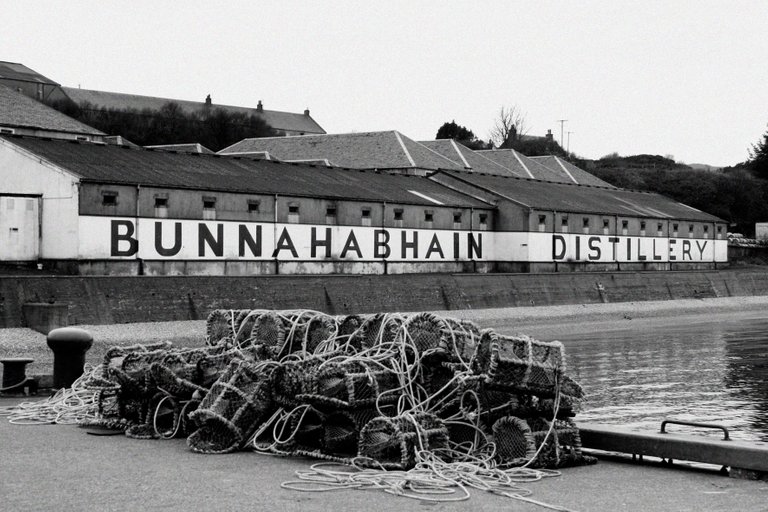Fifty Tastes of Whisky: Bunnahabhain Ceòbanach
Are you in the mood for a wee nip of whisky? Great, because this is the second installation of Fifty Tastes of Whisky! The previous installation about Poit Dhubh 21 can be found over here. This week I will be pouring some Bunnahabhain Ceòbanach. This wasn't a hard choice for me, so let's get to it! Oh, and I'd like you to take a guess what some of the upcoming whiskies might be (you can see a few of them in the background).
Again with the Scot's Gaelic, eh?
Just like my previous review, this distillery and this particular bottling come with Gaelic names. I won't get into the same details on pronunciation as I did in the last review, but I will provide some guidance for those of you who may need a bit of help. If there is real interest in be digging deeper into the language side of things (along the lines how I covered Poit Dhubh in the previous review), then certainly feel free to let me know in the comments.
The way I pronounce Bunnahabhain is more like bunna-haw-vin. The only portion that may come as a surprise is the v sound, but I assure you that is what bh sounds like in Scot's Gaelic (except when it is silent). As for meaning, I have see it translated as meaning "foot of the river" or "river mouth", but I think the most correct/literal translation for "bun na h-abhain" is "the bottom (or base) of the river".
For Ceòbanach, I simply follow the guide on the packaging, which is kyaw-bin-och. Nothing overly complicated with this one. The label says that Ceòbanach means "smoky mist". The actual translation is simply drizzling rain or moist mist or fog.
Finally, I thought I should mention the usual pronunciation of Islay. Despite the spelling, it is usually spoken as EYE-luh. So if you hear someone talking about "an EYE-luh", they really mean a Scotch whisky from the island of Islay.

Bunnahabhain Distillery
This distillery bestows its name upon the village that was founded when the distillery was established in 1881, and is found on the remote north-east coast of Islay (very near to the Margadale River). That's right -- the town exists because of the distillery, and it is still the number one employer in the village. The Bunnahabhain Distillery uses un-chilled filtering for all of their single malts, thanks to their master distiller/blender, Ian MacMillan.
Impressions of Bunnahabhain Ceòbanach
Bottling: 46.3% A.B.V., Batch no. 1
Colour: Pale gold. Legs take a few second to form, but then run medium-quick.
Nose: Unmistakeable peat and smoke. Salty sea-side air and iodine. Some vanilla and tar. Light citrus. Upon revisiting, I am also getting butterscotch.
Palate: Begins with an unexpected intense spicy/peppery attack followed immediately with peat. Very dry. Some saltiness and a touch of vanilla. Light fruitiness (pear, maybe?) and cirtus.
Finish: A nice long finish, again, with the smokiness and peat. Some mild sweet notes come out toward the end. I also get a lingering saltiness that I wasn't quite expecting (especially on the lips, almost like you would expect ten minutes after having salty fries or popcorn).
Unlike many other Bunnahabhains (which are usually unpeated), this one tastes more like a traditional peated Islay. The Ceòbanach is technically a NAS (No Age Specification), since there is no age statement on the packaging or bottle. Based on the text on the back of the bottle, we know that this whisky is aged a minimum of ten years in bourbon casks. As I write this, I am giving it more time to open up -- the more time I spend with it, the more complex it is getting. Ceòbanach is indeed a very fine example of a peated Islay, and I will definitely buy this again once this bottle runs dry.
Cheers!

Voted from a fellow whisky drinker. A point of interest, is Isaly really pronounced eye-luh? I thought it was more eye-la!
Excellent question. I was on the fence about including that bit talking about how to say Islay! But I am happy I did. When you say eye-la , I assume you mean a long a, as heard in the word lay. I typically hear it being spoken with a soft uh sound (much the a in soda), and less typically I hear it spoken with a soft "ah" sound (much like the sound in blah) . Either way, the soft sounds I describe are very similar to each other, and might even be used interchangeably. I am quite confident that the long a sound is not used by locals (and Scots in general) when uttering Islay.
All of that, and I ignored the first syllable altogether!!! What I was going to say is that the EYE sound in Islay is just an approximation -- not quite spot on if being spoken by a Scot. In practice, it would be more like the i sound in kite.
Oh aye, I an good with the first syllable!!
Yes I agree with the soda sounding one and you are right it's definitely not the long aigh as in lay. That would be contemptible!! :0)